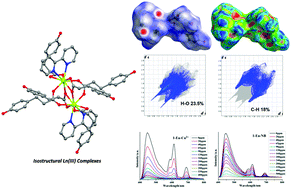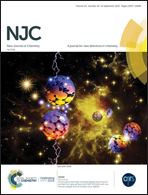Syntheses and crystal structures of new dinuclear lanthanide complexes based on 3-(4-hydroxyphenyl)propanoic acid: Hirshfeld surface analyses and photoluminescence sensing†
Abstract
A series of ten new lanthanide complexes, [Ln2(PA)6(bipy)2]·4H2O·2bipy (Ln = Eu 1, Tb 2, Ce 3, Gd 4, Nd 5, Pr 6, Sm 7, Yb 8) and [Ln2(PA)6(bipy)2]·4H2O (Ln = Ce 9 and Er 10) (HPA = 3-(4-hydroxyphenyl)propanoic acid and bipy = 2,2′-bipyridine), have been synthesized and characterized by microanalysis, FTIR and single crystal X-ray diffraction. The complexes 1–8 and 10 are isostructural and contain two crystallographically equivalent Ln3+ ions having a coordination number 9 with distorted monocapped square-antiprism geometries in which the PA ligands adopt bridging, bidentate chelating, and tridentate chelating bridging modes to coordinate with the Ln3+ ions, while complex 9 possesses a tricapped trigonal prism geometry where only bridging, bidentate chelating modes are adopted by the PA ligands. All the complexes display a 2D supramolecular layered framework held by weak C–H⋯π, π⋯π and O–H⋯O intermolecular interactions. These interactions have been validated by Hirshfeld surface analysis. Additionally, emission studies indicated that amongst all the complexes, 1 and 2 can act as luminescent sensors for the detection of nitrobenzene and Cu2+ ions. The limits of detection (LODs) using both 1 and 2 for nitrobenzene are 3.66 and 3.71 ppm, respectively and for Cu2+ ions, they are 2.11 and 2.99 ppm, respectively.



 Please wait while we load your content...
Please wait while we load your content...